
Working Group: Materials and Interfaces
With their decisive role for numerous natural and technological processes which range from nanoelectronics, sensor technology, solid state lighting, catalysis and solar conversion, surfaces and interfaces dominate most physicochemical processes occurring within functional nanomaterials. Interfaces can be engineered to tune the function and stability of nanostructures, but also induce complex assembly at the meso- and the microscale, providing access to a range of new materials.
The group has profound expertise in functional properties of local surface and interfaces within nanostructured solids. This includes:
- characterization and engineering of defects and impurities in metal oxide nanostructures,
- study of charged surfaces in the context of photoelectrochemical applications,
- metal/semiconductor and plasmonic materials.
Various methods are employed to generate pure and nanoparticle composites in the form of dry powders, colloidal dispersions or thin nanostructured films with specific chemical, optical and electronic properties. Furthermore, our research aims at the understanding of growth and stability of these metastable nanoscale solids in order to determine their potential use and reliability under realistic operation conditions.
Methods
Powders and colloids as well as dense and porous thin films are prepared by gas-phase and wet-chemical synthetic strategies (chemical vapor synthesis, hydrothermal synthesis, thin film deposition by DC and RF sputtering, electrophoretic thin film deposition, electrochemical deposition within porous membranes, nanosphere lithography, metal assisted chemical etching).
Following synthesis the materials are processed in a controlled way (e.g. by thermal sample activation in defined atmospheres to obtain clean surfaces) and transferred into defined environments (high vacuum conditions, gas atmospheres, liquids and electrolytes). Compositional and microstructural materials properties are studied by a combination of spectroscopic methods (UV/Vis spectroscopy in transmission and diffuse reflectance, IR spectroscopy in transmission and attenuated total reflection), electron microscopy (SEM and TEM including elemental analysis and electron diffraction) as well as techniques for the characterization of colloidal properties (dynamic light scattering, laser Doppler electrophoresis).
Defect generation as well as recombination, transport and transfer of charge carriers are studied by a combination of spectroscopic (photoluminescence, electron paramagnetic resonance, cathodoluminescence), electric (4-point probe measurements, electron-beam induced current measurements) and electrochemical techniques (IR and UV/Vis spectroelectrochemistry, photoelectrochemistry).
The materials performance is evaluated by determining e.g. the photoluminescence quantum yield at particle powders and colloids or the external and internal conversion efficiencies of photoelectrodes.
Selected publications:
- Defects in Oxide Particle Systems, T. Berger and O. Diwald, in “Defects on Oxide Surfaces” edited by J. Jupille, G. Thornton, Springer Series on Surface Science, Vol 58, Pages 273-301 (2015)
- Traps and Interfaces in Photocatalysis: Model Studies on TiO2 Particle Systems, T. Berger and O. Diwald in Photocatalysis Fundamentals and Perspectives, RSC Energy & Env. Series No. 14,: ed. Jenny Schneider, Detlef Bahnemann, et al., p 185-215, in press, © The Royal Society of Chemistry 2016
- Interfaces in nanocrystalline Oxide Materials: from Powders towards Ceramics, O. Diwald, K. P. McKenna, A. L. Shluger, in “Computational Modeling of Inorganic Nanomaterials” edited by S. T. Bromley, M. Zwijnenburg; CRC Press, ISBN-13: 978-1466576414, in press (2016)
- The Electrochemistry of Nanostructured Titanium Dioxide Electrodes, T. Berger, D. Monllor-Satoca, M. Jankulovska, T. Lana-Villarreal, R. Gómez ChemPhysChem 2012, 13, 2824-2875.
Team
- DIWALD Oliver, Univ. Prof. Dr. (head)
- BERGER Thomas, Assoz. Prof. Dr.
- Bourret Gilles R., Assoz. Prof. Dr.
- AICHER Korbinian, MSc.
- BARTSCHMID Eva Theresa, BSc.
- NEIGE Ellie, Dipl.-Chem.
- PIASKOWSKI Joshua, MSc.
- RAZOUQ Hasan, MSc.
- SCHWAB Thomas, MSc.
Research Themes:
Stability and transformation of non – equilibrium solids
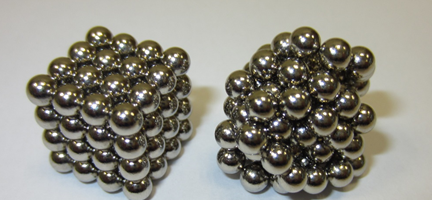
Nanostructures typically form under kinetic control. The structural and compositional relaxation/ reorganization pathways these metastable solids undergo toward their equilibrium state are often not understood. Understanding such processes is crucial to control stability and performance of functional nanostructures in devices.
Selected Publications:
- Thin Water Films and Magnesium Hydroxide Fiber Growth; A. Gheisi, A. Sternig, G.J. Redhammer, and O. Diwald*; RSC Advances, 5 (2015) 82564-82569.
- Morphology and photoelectronic Properties of layered Titanate Nanostructures, A. Riss, M.J. Elser, J. Bernardi, O. Diwald, J. Am. Chem. Soc., 131 (2009) 6198–6206.
- Nanoparticles as Support: CaO Deposits on MgO Cubes, M. Müller, A. Sternig, S. Stankic, M. Stöger-Pollach, J. Bernardi, E. Knözinger, O. Diwald; J. Phys. Chem. C, 112 (2008) 9120-9123
Interfacing Nanostructures
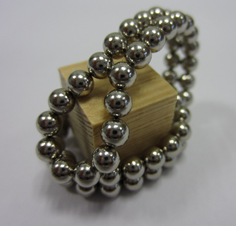
When discussing how the chemical and physical properties of nanoparticle powders differ from those of macroscopic materials, it is common to point to their high specific surface area, the size and shape of the constituent nanocrystals, and the high concentration of surface features, such as steps, kinks, and other low coordination sites. Another defining characteristic of this type of materials is the large number of interfaces between nanocrystals they contain. However, the beneficial and/ or detrimental influence of interfaces on the overall properties of nanoparticle powders has not been studied and is only rarely understood. In this project we explore different possibilities to selectively generate these interfaces and to directly address them by chemistry, light or thermal materials processing. Related activities aim at new means for functionalization and chemical activation of oxide nanostructures and, consequently, at improving performance and reliability for many nanoparticle powder applications.
Selected Publications:
- Traps and Interfaces in Photocatalysis: Model Studies on TiO2 Particle Systems, T. Berger and O. Diwald in Photocatalysis Fundamentals and Perspectives, RSC Energy & Env. Series No. 14,: ed. Jenny Schneider, Detlef Bahnemann, et al., p 185-215, in press, © The Royal Society of Chemistry 2016
- Porphyrin Metalation at MgO Surfaces: A Spectroscopic and Quantum Mechanical Study on Complementary Model Systems; J. Schneider, M. Franke, M. Gurrath, M. Röckert, T. Berger, J. Bernardi, B. Meyer*, H.-P. Steinrück, O. Lytken*, and O. Diwald*; Chem Eur. J. 22 (2016) 1744 – 1749.
- Optical Properties of Nanocrystal Interfaces in Compressed MgO Nanopowders K. McKenna, D. Koller, A. Sternig, N. Siedl, N. Govind, P.V. Sushko, and O. Diwald, ACS Nano, 5 (2011) 3003-3009.
- Particle Networks from Powder Mixtures: Generation of TiO2-SnO2 Heterojunctions via Surface Charge-Induced Heteroaggregation, N. Siedl, S. O. Baumann, M. J. Elser, and O. Diwald*, J. Phys. Chem. C 116 (2012) 22967-22973.
Doping, Decoration and impurity admixture
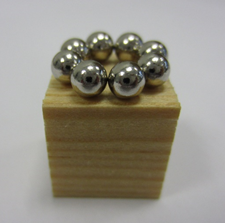
In oxide nanostructures compositional heterogeneity can range from impurity doping of the host lattice to phase separated nanocomposites with multifunctional properties. In this project we aim at the assessment of wanted and unwanted properties of extrinsic defects as well as materials alloying and segregation effects at the nanoscale.
Selected Publications:
- Solar Light and Dopant induced Recombination Effects in TiO2: photoactive Nitrogen as a Case Study, M. D’Arienzo, R. Scotti, F. Morazzoni, N. Siedl, A. Sternig, J. Bernardi, and O. Diwald; J. Phys. Chem. C 114 (2010) 18067-18072.
- Surface-specific visible Light Luminescence from composite Metal Oxide Nanocrystals; A. Sternig, J. Bernardi, K. Mc Kenna*, and O. Diwald*, J. Mater. Sci. 50 (2015) 8153-8165.
- Phase Separation at the Nanoscale: structural Properties of BaO Segregates on MgO-based Particles; A. Sternig, S. Klacar, J. Bernardi, M. Stöger-Pollach, H. Grönbeck, and O. Diwald, J. Phys. Chem. C, 115 (2011) 15853-15861.
Electron Centers in Semiconductor electrodes
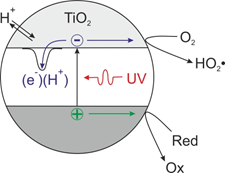
Some material properties depend not only on synthesis and processing parameters, but may furthermore significantly change during operation. This is particularly true for high surface area materials. One example is the degree of hydrogen-doping in mesoporous semiconductor thin films in contact with an aqueous electrolyte, which may change during a photocatalytic process. In situ tracking of such dynamic property changes is very challenging. However, knowledge of the thermodynamic and kinetic details of the underlying microscopic processes is extremely important as they may strongly influence the macroscopic electrode performance.
Selected Publications:
- Defects in porous networks of WO3 particle aggregates A. Márquez, M. J. Rodríguez-Pérez, J. A. Anta, G. Rodríguez-Gattorno, G. R. Bourret, G. Oskam, T. Berger* ChemElectroChem 2016, 3, 658.
- Spectroscopic properties of electrochemically populated electronic states in nanostructured TiO2 films: Anatase versus rutile T. Berger*, J. A. Anta, V. Morales-Flórez Phys. Chem. Chem. Phys. 2013, 15, 13790.
- Electrons in the Band Gap: Spectroscopic Characterization of Anatase TiO2 Nanocrystal Electrodes under Fermi Level Control T. Berger*, J. A. Anta, V. Morales-Flórez J. Phys. Chem. C 2012, 116, 11444.
Photoinduced reactions on semiconductor electrodes
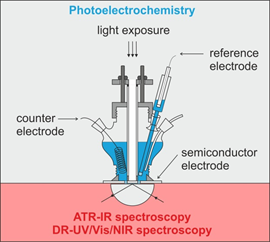
Nanostructured semiconductor thin films as used in photocatalysis, sensors, electrochromic devices and new generation solar cells constitute highly complex systems. Many of the applications of semiconductor electrodes rely on the generation, transport and recombination of charge carriers, which imparts a central importance to electrochemical studies. In our laboratory we combine electrochemical measurements with spectroscopic techniques (UV/Vis/NIR and ATR-IR spectroscopy), which provide complementary, chemically specific information. These spectroelectrochemical techniques allow us to track simultaneously both the integral (photo)electrochemical properties of a nanostructured semiconductor electrode and the temporal evolution of reaction educts and products at the oxide/solution interface in the course of photocatalytic reactions.
Selected Publications:
- Modification of Mesoporous TiO2 Films by Electrochemical Doping – Impact on Photoelectrocatalytic and Photovoltaic Performance J. Idígoras, T. Berger*, J. A. Anta* J. Phys. Chem. C 2013, 117, 1561
- IR-Spectrophotoelectrochemical Characterization of Mesoporous Semiconductor Films T. Berger*, J. A. Anta Anal. Chem. 2012, 84, 3053.
- A macroscopic and molecular view of photoinduced reactions on nanostructured semiconductor thin films T. Berger, A. Rodes, R. Gómez* Chem. Commun. 2010, 46, 2992.
Plasmonic Materials
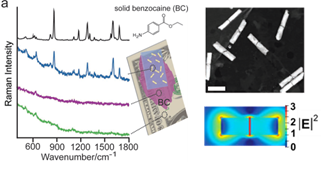
Metal nanostructures can sustain plasmonic resonances that are fully tunable from the UV to the IR range. These materials can be used for enhancing technologically important processes such as surface-enhanced Raman scattering (chemical sensing) or light absorption within semiconductors (solar conversion). We are currently developing smart synthetic strategies to control the integration of plasmonic materials within functional systems.
Selected Publications:
- Investigation of Mass Produced Substrates for Reproducible Surface Enhanced Raman Scattering Measurements over Large Areas, A. Reyer,* A. Prinz, S. Giancristofaro, J. Schneider, D. B. Menezes, G. Zickler, G. R. Bourret,* and M. E. Musso, ACS Appl. Mater. Interfaces, 2017, 9, 25445-25454, DOI: 10.1021/acsami.7b06002
- Coaxial Lithography, T. Ozel, G. R. Bourret, and C. A. Mirkin, Nature Nanotechnology 10 (2015) 319–324, DOI:10.1038/nnano.2015.33
- Long-Range Plasmophore Rulers, G. R. Bourret, T. Ozel, M. Blaber, C. Shade, G. C. Schatz and C. A. Mirkin Nano Lett. 13 (2013) 2270, DOI: 10.1021/nl400884j
- Dispersible Surface Enhanced Raman Scattering Nanosheets, K. D. Osberg, M. Rycenga, G. R. Bourret, K. Brown and C. A. Mirkin Adv. Mater. 24 (2012) 6065, DOI: 10.1002/adma.201202845
Growth and organization of nanomaterials
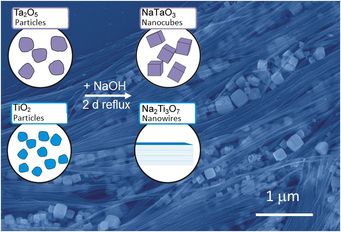
Beginning from intense research on size effects specific to individual nanoscale building blocks the need to arrange metal oxide nanoparticles at the meso- and macroscale has emerged as an important and urgent research topic in current nanoscience. This includes the assembly of nanoscale building blocks over several lengths scales from the nano- to the centimeter range retaining the nanoscale properties in the final macroscopic object or device. As a matter of fact interfaces between the nanoobject and surrounding materials environment emerge from this materials organization step. This project aims at the elucidation of how growth and microstructure evolution different types of interfaces impact the overall ensemble properties in terms of microstructure, optical, electronic and chemical properties.
Selected Publications:
- On the entangled Growth of NaTaO3 Cubes and Na2Ti3O7 Wires in Sodium Hydroxide Solution, S.O. Baumann, C. Liu, M.J. Elser, A. Sternig, N. Siedl, T. Berger, O. Diwald*, Chemistry – A European Journal, 19 (2013) 10235-10243.
- Defects in Oxide Particle Systems, T. Berger and O. Diwald, in “Defects on Oxide Surfaces” edited by J. Jupille, G. Thornton, Springer Series on Surface Science, Vol 58, Pages 273-301 (2015)
- Solid-Solid Interface Formation in TiO2 Nanoparticle Networks; S. Baumann, N. Hüsing, M.J. Elser, O. Diwald, Langmuir 27 (2011) 1946-1953.
Biological activity of metal oxide nanostructures
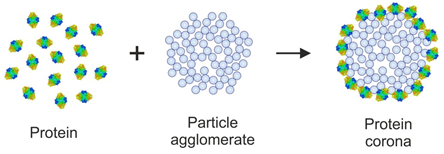
An unambiguous description of the protein adsorption behavior on synthetic nanomaterials on the basis of physicochemical particle properties is complicated by the complexity of the underlying system. We focus therefore on the preparation and study of systems featuring well-defined particle properties. Upon transfer of gas-borne nanoparticles into aqueous dispersion the effect of proteins on the agglomeration and dispersion state of metal oxide nanoparticles and the reverse effect of particles on protein conformation and biological activity are addressed.
Selected Publications:
- Bovine Serum Albumin Adsorption on TiO2 Colloids: The Effect of Particle Agglomeration and Surface Composition, Márquez, A., Berger, T.*, Feinle, A., Hüsing, N., Himly, M., Duschl, A., Diwald, O. Langmuir, 33 (2017) 2551-2558
- Enzyme Adsorption-induced Activity Changes: A quantitative Study on TiO2 Model Agglomerates, Márquez, A., Kocsis, K., Zickler, G.; Bourret, G.R.; Feinle, A.; Hüsing, N.; Himly, M.; Duschl, A.; Berger, T.*; Diwald, O.; Journal of Nanobiotechnology 15 (2017), Article # 55




